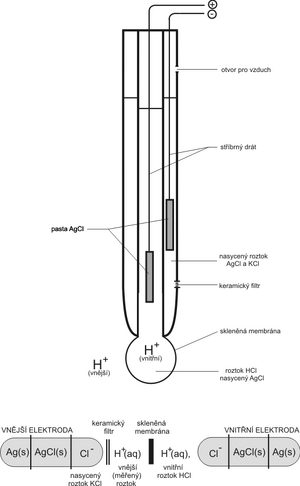Glass electrode
The oldest and still most widespread ion-selective electrode that is used to measure pH, is the glass electrode. As a rule, it is constructed in one body directly with a suitable reference electrode. There are a number of modifications; here we will show the principle on the basic design.
The ability of the glass electrode to indicate the concentration of H + can be simply explained by the fact that the glass membrane (a well with very thin walls blown from special glass) is permeable to H + and impermeable to other ions. A silver wire covered with a layer of AgCl is immersed in the internal electrolyte. Depending on the acidity of the measured solution, the concentration of H + inside the flask changes. Cl − ions do not pass through the membrane, so in order to maintain the electroneutrality of the solution, the reaction takes place at the electrode
- AgCl + e− ⇔ Ag+ + Cl−
If we immerse the electrode in an acidic solution, the excess of H + ions will cause more Cl − ions to be released from the AgCl paste . This consumes more electrons from the silver wire and the electrode gets a more positive voltage compared to the reference. Conversely, in an alkaline environment, excess Cl − will donate its electrons and the electrode will have a more negative voltage.
A silver wire coated with AgCl paste is most often used as a reference electrode in pH-meter, but this time it is immersed in a KCl solution with a precise concentration (i.e. in a solution with a constant concentration of Cl − , e.g. saturated, 1 mol·l −1 , 3 mol·l −1 etc.). The potential of the reference electrode is not affected by the concentration of H + ions. The electrolyte of the reference electrode is conductively connected to the measured solution by means of a bridge with a ceramic partition (frit).
The given description of the pH-metric electrode is greatly simplified. The actual steps on the glass membrane are described in the glass electrodes details.

